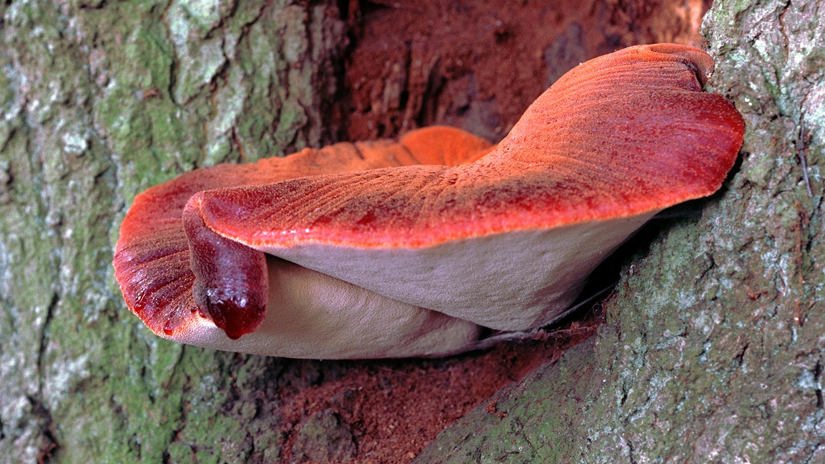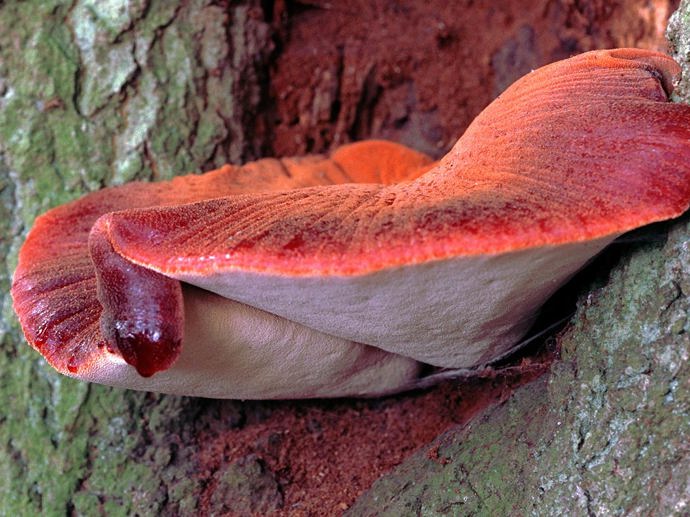Common names: wood blewit, blue hat, blue cap, blue leg
Scientific name: Clitocybe nuda, sometimes recorded as Lepista nuda
Family: Tricholomataceae
Fruiting season: September to December
Habitat: coniferous and deciduous woodland
Pastel-toned and edible with a magical twist. Wood blewit has a blue to violet-tinged cap and gills when young, with pale pink spores. It sometimes grows in circles called ‘fairy rings’, which can appear overnight and were once thought to indicate that magic was at work.
Common names: wood blewit, blue hat, blue cap, blue leg
Scientific name: Clitocybe nuda, sometimes recorded as Lepista nuda
Family: Tricholomataceae
Fruiting season: September to December
Habitat: coniferous and deciduous woodland
This edible mushroom can be quite chunky looking, with a blue-lilac tinge on the cap and a bluer hue to the gills and stalk – especially when young.
Cap: stocky, 6–15cm in diameter with a blue-violet tinge.
Gills/spores: gills are crowded and grow into the stalk, in young mushrooms they have a blue-lilac colour but the gills turn brown as the mushroom matures. Spores are pale pinkish.
Stipe (stalk): 15–25mm in diameter and 5–10cm tall. It may have a swollen base. Blue tinged, especially when young.
Not to be confused with: species from the Cortinarius genus, especially as some of these also have a blue-lilac tinge. But they have a rather unpleasant smell and their gills are brown.

Credit: Chris O'Reilly / Alamy Stock Photo
Wood blewit is widespread and common in the UK, Ireland and mainland Europe and in many other parts of the world, including North America. Look for it in the leaf litter in coniferous and deciduous woodland and under hedgerows.
Blewits only start to appear when the temperature drops to below 17 degrees as they like the cold and will survive a frost quite easily.
The wood blewit’s occasional habit of growing in rings, called fairy rings – a tendency seen in a number of fungi species – has long been part of European folklore. Some believe the rings symbolised a place where fairies, pixies or elves danced in the woods. Others believe that the rings were a portal between the fairy world and the human world. However, most cultures considered them dangerous places for humans. Many myths warned that anyone entering a fairy ring was likely to die young and would either become invisible to the mortal world, unable to escape the ring, or be transported instantly to the fairy world.
The rings are actually a natural phenomenon resulting from the way the mycelium grows underground. Starting at a single point it grows outwards in a circular motion, searching for more nutrients. Over time, the circle of fruiting bodies above ground will appear in an ever widening circle, reflecting the mycelium beneath.


Credit: Blickwinkel / Alamy Stock Photo
Wood blewits are generally regarded as edible mushrooms as long as they're cooked thoroughly. It has a distinctive, strong flavour and smells faintly of aniseed, and is good in stews, omelettes or fried in butter. However, there are cases of it causing allergic reactions when eaten raw, and in some people even when it's cooked. It can also be used as a dye, resulting in a green-grass colour – not purple or pink as might be expected.
According to records, wood blewit was eaten by people as early as the 18th century.


Helen Keating • 29 Oct 2018
Explore the world of foraging with these top wild fungi picking and cooking tips. Here are five edible fungi that are easy to identify.